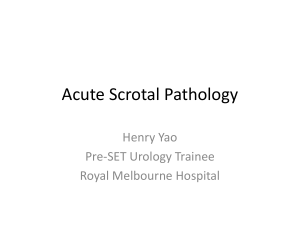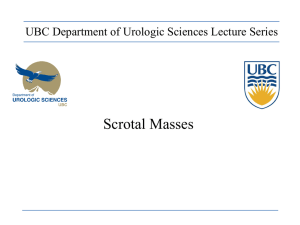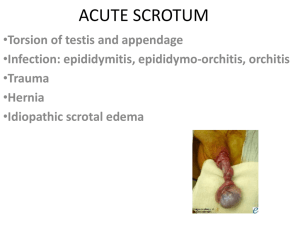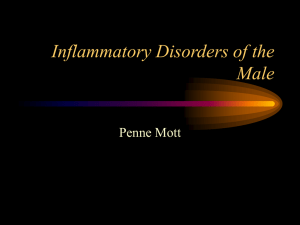Basics Peds Urology Dr Michael Leonard 2014
advertisement
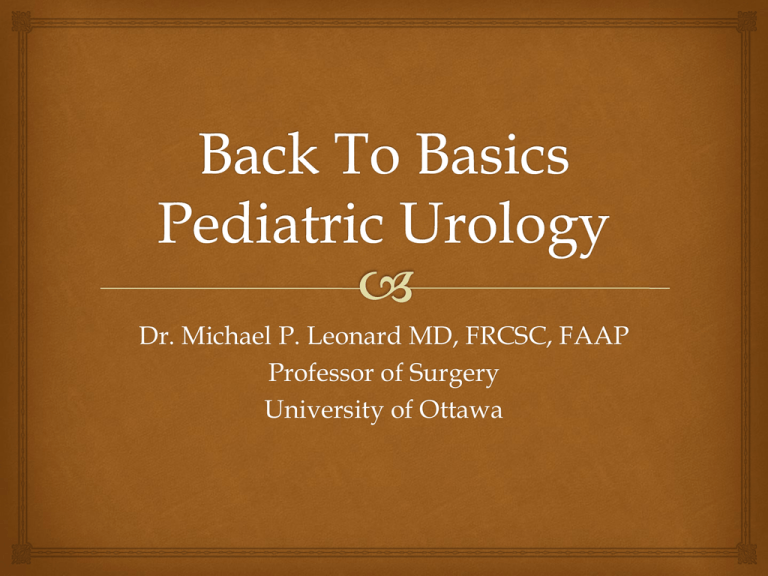
Dr. Michael P. Leonard MD, FRCSC, FAAP Professor of Surgery University of Ottawa Urinary Tract Infections Caused by gut bacteria E. coli most common Ascend via urethra to bladder and kidneys Presentation varies with age: Infants – fever, lethargy, diminished feeding, failure to thrive, diarrhea, vomiting Children – frequency, urgency, dysuria, wetting, gross hematuria, abdominal pain, fever Urinary Tract Infections Incidence < 1 yr – more common in males (peak 6 months) Increased in uncircumcised males (10x) > 1 yr – more common in females (peak 2-3 years) School age children: 1.2% males 5% females Urinary Tract Infections Diagnosis Obtain urine sample for urinalysis / culture Methods of obtaining urine: Infant = bag urine, catheterized urine Child = midstream urine, catheterized urine Beware contamination! Urinalysis: +ve nitrite, leucocyte esterase, RBC Culture: > 108 CFU/l of one organism Urinary Tract Infection Treatment Antibiotics IV ± hospital admission if systemically unwell (especially infants) IV ampicillin / cephalosporin and gentamicin initially Oral if reasonably stable and not toxic Trimethoprim, TMP-SMX, nitrofurantoin, cephalosporin Broad spectrum to cover gram negative and some gram positive (Staph, Enterococcus) No worry regarding anaerobes Duration of treatment 7-14 days depending on clinical scenario Urinary Tract Infection Investigation AAP Guidelines 2011 First febrile UTI 2-24 months = renal ultrasound VCUG only if abnormal US or second febrile UTI “Top down approach” DMSA scan to document evidence of APN VCUG only if findings APN on DMSA Urinary Tract Infection Referral ? Consider referring the following to specialist: GU anomalies on US and/or VCUG VUR, hydronephrosis, ureterocoele Concern regarding neurogenic features Abnormal lower back exam VACTERL syndrome Recurrent UTI in the otherwise normal child if not responsive to timed voiding and management of constipation Vesicoureteric Reflux (VUR) Urine washing back to kidneys from bladder = VUR Increases risk of renal infection if UTI Renal infection may lead to scarring Associated with renal dysplasia ± renal scarring More common in males < 1 yr and females > 1 yr Seen in 35-50% of children with UTI Diagnosed by VCUG VUR - Grading VUR - Management Prevent UTI by antibiotic prophylaxis Follow at intervals for resolution Follow-up comprises US and Cystogram Surgical intervention: Breakthrough UTI New scarring Parental preference Surgical options: Minimally invasive (STING) Open ureteric reimplantation VUR - Surgery Nocturnal Enuresis If child wets bed at ≥ 5 years of age = NE Common developmental issue: 15% of 5 year olds 1% of 15 year olds 15% spontaneously resolve annually Family history common (genetic component) Several theories abound: Developmental delay of normal maturation Deep sleep patterns Bladder over-activity at night Lack of nocturnal ADH production Nocturnal Enuresis Classification Primary nocturnal enuresis (PNE) No day time symptoms No dry interval 6 months or longer Secondary nocturnal enuresis As above but with dry interval > 6 months at some time in past Complicated nocturnal enuresis Day time symptoms ± UTI Nocturnal Enuresis Evaluation (Rushton, J Pediatr) NOCTURNAL ENURESIS Evaluation UNCOMPLICATED Primary onset Normal daytime habits Urinalysis / culture Physical exam COMPLICATED Dysfunctional elimination UTI +ve Renal US VCUG ** - ve No further studies Urodynamics Neurosurgery consult ** minority of patients Nocturnal Enuresis: Treatment Three primary treatment modalities: Observation: fluid restriction, double void at night, star charts Conditioning therapy: bedwetting alarm system Pharmacotherapy: DDAVP Daytime Wetting Toilet training complete at 2-3 years 5% of 5 year olds experience occasional daytime wetting Causes: anatomical (ectopic ureter, epispadias) pseudo-incontinence (vaginal voiding) neurogenic (spina bifida) dysfunctional elimination (DE) Daytime wetting - DE Bladder problems: overactive bladder (OAB) hypoactive bladder detrusor / sphincter incoordination Bowel problems: fecal impaction colonic distension hypotonicity pelvic floor / sphincter tone Daytime wetting -Rx Anatomical: surgery (i.e. hemi-nephrectomy) Pseudo-incontinence: change of voiding posture Neurogenic: improve storage (anti-cholinergics) improve emptying (IMC) Daytime wetting -Rx Dysfunctional elimination: improve bowel function (diet) timed voiding (q 2-3h) biofeedback medication: anti-cholinergics -blockers psychotherapy NORMAL SCROTAL ANATOMY Acute Scrotum Case study #1: 14 year old boy with right hemi-scrotal pain Duration of pain = 6 hours No history of trauma or LUTS What else do you need to know?? What is your differential diagnosis?? Are any ancillary investigations useful?? TESTIS TORSION • Clinical Presentation: – pubertal boy (12-16 years) – abrupt onset lower abdominal / testicular pain – pain usually severe, unrelenting – associated with nausea, vomiting, anorexia – prior history of trauma (minor) – previous episodes which resolved TESTIS TORSION • Physical Findings: – elevated testis with abnormal lie – “knotting” of spermatic cord – absent cremasteric reflex – scrotal erythema / edema – reactive hydrocoele – “bell clapper” contralaterally TESTICULAR TORSION DIFFERENTIAL DIAGNOSIS • Emergent: – Testicular torsion – Traumatic testicular rupture – Incarcerated inguinal hernia – Peritonitis with patent processus vaginalis – Fournier’s gangrene DIFFERENTIAL DIAGNOSIS • Non-emergent – Torsion of testicular or epididymal appendage – Acute epididymo-orchitis – Idiopathic scrotal edema – Henoch-SchÖnlein purpura – Hydrocoele / hernia – Acute hemorrhage into testicular neoplasm TESTIS TORSION • Laboratory Studies: – urinalysis typically negative, but may contain WBC’s – CBC and differential not useful discriminator • Radiographic Studies: – not indicated if typical clinical case with duration of pain < 12 hours! TESTIS TORSION • When should radiographic studies be considered? – duration of pain > 12 hours and / or diagnosis is uncertain • Which study is indicated? – Color Doppler ultrasonography TESTIS TORSION • Color Doppler ultrasound – readily available in most locales – positive finding = no or decreased flow in affected testis – sensitivity 91% (range 82-100%) – pitfalls: •small (infant) testis = no flow •peri-testicular flow due to inflammation around torted testis TESTIS TORSION TESTIS TORSION • Time is of the essence! – salvage is usually successful within 6-8 hours after onset of pain – salvage possible up to 24 hours, but rate declines exponentially – pain > 24 hr invariably = necrotic testis (very rare exception!) TESTIS TORSION • Surgical Results: – salvage rates approximate 60-70% – factors contributing to missed torsion: •patient delay in presentation = 80% •physician mis-diagnosis = 20% – suggests need for education through school health / physical education programs TESTIS TORSION EXTRA-VAGINAL TESTIS TORSION (NEONATAL) • Occurs ante-natally (in utero) or in the first week post-natally • Testis and tunica vaginalis rotate together (inadequate scrotal wall fixation) • Presents as painless scrotal swelling with scrotal erythema / bluish discoloration • Testis rarely viable - ? need for surgery TORSION OF TESTICULAR APPENDAGE Case study #2: 8 year old boy 2 day history right hemiscrotal pain Anything else you want to know?? TORSION OF TESTICULAR APPENDAGE • Clinical presentation: – 7-12 year old (pre-pubertal) boy – pain more indolent, not as severe as testis torsion – pain may resolve with rest – usually no accompanying nausea or vomiting TORSION OF TESTICULAR APPENDAGE • Physical Exam: – early •testis has a normal lie •maximal tenderness at upper pole •tender nodule may be seen (“blue dot”) or felt – late •progressive scrotal erythema and edema •reactive hydrocoele •more difficult to differentiate from testis torsion TORSION OF TESTICULAR APPENDAGE • Laboratory investigations: – urinalysis usually negative • Radiographic evaluation: – Color Doppler ultrasound shows increased flow to upper pole testis / epididymis. May also see small hypoechoic torted appendage. – Radionuclide scan shows increased blood flow to the affected hemi-scrotum TORSION OF TESTICULAR APPENDAGE • Treatment: – limit physical activity – analgesia – expect an initial increase in swelling / redness with resolution over 7-10 days – surgery only necessary if diagnosis in doubt and / or pain not well managed by analgesics – no long term sequelae re: testicular function EPIDIDYMITIS Case study #3: 10 year old boy 2 day history left hemiscrotal pain and swelling LUTS for 3 days Febrile (39.5C) Any further investigations / information required?? EPIDIDYMITIS • Bacterial or chemical inflammation of epididymis • Rare in pre-pubertal boys – if occurs, consider urinary tract abnormality such as ectopic ureter, PUV, stricture • Common in sexually active adolescents – usually Chlamydia, rarely gonococcus EPIDIDYMITIS • Clinical presentation: – pain insidious in onset – irritative lower urinary tract symptoms may precede onset of pain – urethral discharge if STD – may be septic EPIDIDYMITIS • Physical examination: – elevated temperature – scrotal edema, erythema, tenderness, reactive hydrocoele, tender prostate – early on epididymis may be increased in size and exquisitely tender – in later stages, loss of anatomical landmarks with diffuse tenderness – Prehn’s sign unreliable! EPIDIDYMITIS • Laboratory investigations: – urinalysis may show pyuria, hematuria, bacteria – urine culture may be positive • Radiographic evaluation – only necessary in pre-pubertal child with concurrent UTI – renal ultrasound and VCUG recommended – if Color Doppler US obtained will show increased blood flow to affected side Scrotal Mass Need to distinguish where mass is coming from: Processus vaginalis: Indirect inguinal hernia Communicating or non-communicating hydrocoele Testicular adnexae: Epididymal cyst / spermatocoele Varicocoele Testis Testicular tumour Scrotal mass in children Hernia - Hydrocoele Embryology As testis descends through inguinal canal into scrotum: carries along a tongue of peritoneum (processus vaginalis) normally communication of processus with peritoneum closes leaves potential space (tunica vaginalis) over anterolateral testis Hydrocoele - Hernia Anatomy Hernia - Hydrocoele Management Communicating hydrocoele: may resolve spontaneously < 2 yr. if persists > 2 yr. repair Indirect inguinal hernia: repair at any age risk of incarceration small but real Non-communicating Hydrocoele Localized collection of fluid in tunica vaginalis May be secondary to: inflammatory process trauma, infection, torsion tumor If concern re: testis ultrasound Surgical intervention is option Hydrocoele - US Epididymal Cyst / Spermatocoele Epididymal cyst common in pre-pubertal boys Usually seen on scrotal US (non-palpable) Benign course May grow and become palpable Spermatocoele seen in post-pubertal boys Blow out of efferent duct encysted collection of spermatozoa Both conditions may cause cosmetic concerns and mandate surgical excision Varicocoele 15% of adolescents have varicocele: rare to have onset prior to adolescence >90% left sided not likely to spontaneously regress Clinical conundrum: how can we predict which patients will suffer gonadal damage from varicocele? Varicocoele - Anatomy Varicocoele Indications for surgery: absolute volume difference > 20% on affected side caveat re: differential growth and need for more than one measurement relative pain cosmesis Varicocoele Ablation Outcomes Testicular Tumour Rare 0.5-2/100,000 children Presents as painless scrotal mass Mass is firm and non-transilluminating Caveat re: hydrocoele and inadequate testicular exam Testis Tumour Histology Testis Tumour Obtain serum markers: -fetoprotein HCG Ultrasound of testis: confirm diagnosis treatment planning Imaging - Testis Tumour Surgical Management Testis Tumour Radiological Staging CXR CT abdomen / pelvis Bone scan (RMS) Management - Non RMS Orchiectomy and surveillance: teratoma / dermoid cyst stage I yolk sac tumour gonadal stromal tumour (Leydig, Sertoli) Chemotherapy (BEP) for yolk sac if: stage II-IV disease relapse stage I Limited role for RPLND in yolk sac Management RMS Radical inguinal orchiectomy Children > 10 yr. undergo ipsilateral RPLND before chemotherapy Chemotherapy in all age groups Radiotherapy in addition to RPLND in children > 10 yr. Higher risk of relapse / spread Neonatal Abdominal Mass Abdominal mass (75% arise in the GU tract) #1-Hydronephrosis (UPJO, VUR, UVJO, PUV) #2-Multicystic dysplastic kidney (MCDK) #3-Tumours account for 12 % Neuroblasoma, CMN and teratoma (sacrococcygeal) Hydronephrosis MCDK Neonatal Abdominal Mass Neuroblastoma is the most common malignancy in the neonate Wilms’ tumour is extremely rare in this age group Abdominal mass + hematuria = renal vein thrombosis Girl with abdominal mass + interlabial bulging = hydrocolpos Congenital Mesoblastic Nephroma (CMN) is the most common renal tumour Abdominal Mass After Neonatal Period From 1 month to 1 year of age: Hydronephrosis – 40% Solid masses and tumour – 40% Older than 1 year of age: Tumour is the most common cause of abdominal mass Neuroblastoma (NB) Most common malignant tumour of infancy 8% to 10% of all childhood cancers Annual incidence 10 cases per 1 million Median age at diagnosis: 22 mo 50% of cases < 2 years of age (75% <4yrs) (Fortner et al, 1968) NB - What and Where? Tumours of neural crest cell origin: Cells that form the adrenal medulla and sympathetic ganglia 75% are retroperitoneal 50% adrenal 25% sympathetic chain (from neck to pelvis) NB - Presentation Often has systemic symptoms (different from WT) Fever, abdominal pain or distension, abd mass, weight loss, anemia, bone pain, proptosis and periorbital ecchymoses (retro-orbital metastasis) Metastases are present in 70% at diagnosis VMA (vanillylmandelic acid), HMA (homovanillic acid) Elevated in > 90% of the neuroblastomas 24 hr urine collection (catecholamine metabolites) NB - Imaging US is usually the first exam in child with abdominal mass CT or MRI Both detect extension beyond midline and hepatic involvement MRI: better displays the relationship with great vessels and detects intraspinal extension (tumor of sympathetic chain) CT may show calcifications (rare in Wilms tumor) NB - Treatment Generally based on risk assessment Tumour stage Grade Biochemical risk factors Genetic risk factors Low-stage favorable Higher risk tumor Very aggressive tumor Surgery alone Adj chemo +/- RT Autologous bone marrow transplantation Wilms' Tumor Most common primary malignant renal tumour of childhood Embryonal tumour develops from remnants of immature kidney Annual incidence 7 to 10 cases per million Median age 3.5 yrs 80% diagnosed < 5 yrs of age Worldwide sex ratio is close to 1 (North American girls slightly > boys) Congenital Anomalies and WT Genitourinary anomalies in 4.5% of WT Renal fusion anomalies Cryptorchidism Hypospadias (Breslow et al, 1993) These are common disorders and screening for WT is not necessary in most children with genital anomalies Syndromes and WT Without overgrowth: Denys-Drash syndrome (DDS) Male pseudohermaphroditism, renal mesangial sclerosis and WT ( Drash et al, 1970) Aniridia (Found in 1.1% of patients with WT) WAGR syndrome Wilms' tumor, Aniridia, Genital anomalies, mental Retardation (Clericuzio , 1993) Horseshoe kidney (NWTSG found 7 times incidence of WT) Syndromes and WT With overgrowth Hemihypertrophy May occur alone or with syndromes Beckwith-Wiedemann (BWS) Perlman Soto Simpson-Golabi-Behmel Imaging in WT Ultrasound is the first study performed in most children with an abdominal mass Solid nature of the lesion CT shows the relationship with other organs MRI is the study of choice if extension of tumour into the inferior vena cava cannot be excluded by ultrasound (Weese et al, 1991) Treatment of WT Surgical Radical nephrectomy Accurate staging to determine need RT +/- chemo Exploration of the abdominal cavity Liver, nodal metastases, peritoneal seeding Formal exploration of the contralateral kidney Not necessary with modern imaging Formal retroperitoneal lymph node dissection not recommended
